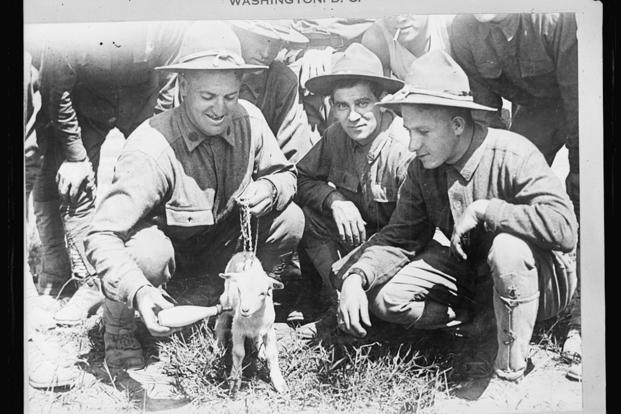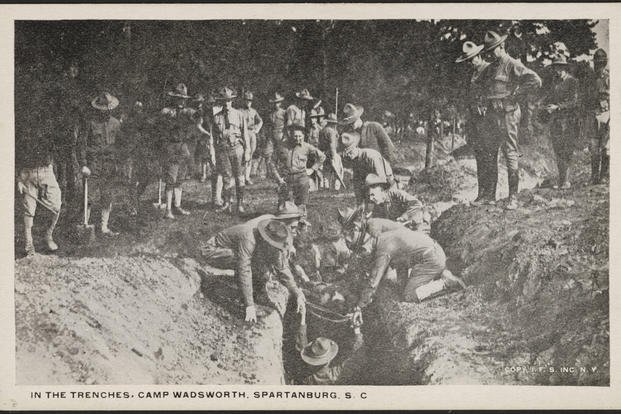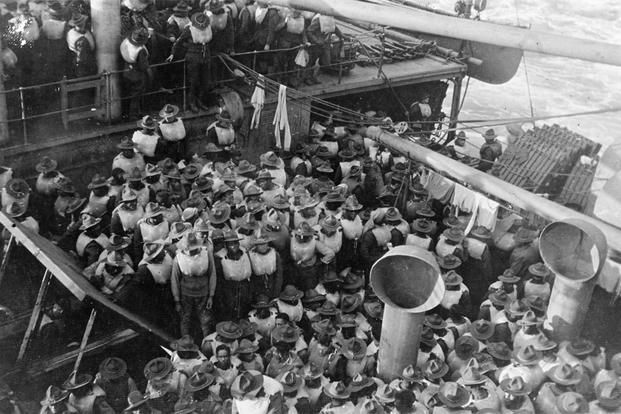As April 1918 became May, the 27,000 soldiers of the New York National Guard's 27th Division left Camp Wadsworth, South Carolina, and boarded trains and ships heading for France, where World War I was raging.
The 27th Division, which included all but two regiments of the New York National Guard, left New York in August and September 1917. There had been a massive parade down Fifth Avenue when the division left, and then eight months of training began.
Led by Maj. Gen. John F. O'Ryan, the National Guard soldiers built their own camp, dug practice trenches and lived in them, learned to shoot and reorganized for war. An influx of 2,300 "national army" draftees from Camp Upton on Long Island brought the division up to strength.
First to leave was the 107th Infantry Regiment, the old 7th Regiment of the New York National Guard. The 7th was famous as the "silk stocking regiment" filled with socially prominent members.
The regiment turned in old equipment and drew new gear, including swapping their 1903 Springfield rifles for the M1917, an American-made version of the British Lee-Enfield rifle.
The headquarters left Camp Wadsworth on April 28. The rest of the regiment left on April 29 for Newport News, Virginia.
On May 9, the regiment boarded the USS Susquehanna and the USS Antigone, former German ocean liners that were now put to work carrying American troops who would fight German ones.

Fourteen ships carried the 107th Infantry from Newport News to Brest, France. The 12 days at sea were broken up by abandon ship drills, and soldiers were assigned the duty of watching for German submarine periscopes.
The 106th Infantry left Camp Wadsworth on May 6 and boarded the troop transport USS President Lincoln -- which has also been called the President Lincoln by its former owner, the German Hamburg-Amerika Line -- in Hoboken, New Jersey, on May 10.
The enlisted soldiers, according to one writer, were packed into the hold in long aisles of bunks made of wood and chicken wire with straw mattresses. The bunks were three or four high. "The bottom man was almost on the floor while the top man was practically against the ceiling," a soldier recalled.
The portholes were closed at night to black out the ships against submarines. In the stifling hold, men got seasick and vomited when the ship rolled.
One of those on board the President Lincoln was a 42-year-old private named Edward " Monk " Eastman, a member of G Company. Because he was 20 years older than most of the men, they called him Pops, according to author Neil Hanson.
Eastman had been a New York City gangster and commanded an army of 1,200 "pickpockets, thieves, thugs and prostitutes." But he'd serve a lengthy prison sentence in Sing Sing, and when he got out, his gang was gone, but his enemies still remained.
So Eastman left town and joined Brooklyn's 106th Infantry.
While getting his induction physical, he amazed his doctors, according to Hanson, the author of "Monk Eastman, the Gangster Who Became a War Hero."
There were razor and knife scars all over his body, as well as bullet wounds. His ears had been shredded in fights and his nose was flat. What battles had he been in, a doctor asked?
"Oh, just a lot of little private wars around New York," Eastman replied.
Eastman may have been older than the other soldiers but he was tough, according to Hanson. In France, he earned a reputation for being fearless in battle.
There were stories of him single-handedly wiping out machine-gun nests, saving wounded soldiers and leaving his hospital bed to rejoin his unit.
When the 106th returned from France in 1919, Gov. Al Smith restored his voting rights, which he'd lost as a result of previous felony convictions.
Eastman and the other 3,287 members of the 106th got off the President Lincoln in Brest on May 25.

The President Lincoln loaded sick soldiers heading back to the United States, left the harbor, and was torpedoed and sunk by a German submarine on May 31.
None of the ships carrying 27th Division soldiers was sunk by a submarine. But on May 29, a convoy carrying the division's headquarters company was attacked at 5:20 p.m. by a U-Boat, according to O'Ryan in his book, "The Story of the 27th Division."
The American ships fired back, destroyers dropped depth charges and the submarine was reported destroyed.
Quarters on the ships were tight, but the men were well-fed and many of them spent time catching up on sleep, O'Ryan reported. Soldiers who could sing or dance or tell jokes put on shows. Movies were shown.
Other soldiers published shipboard newspapers.
On board the USS Calamares, there was a paper called "the Sea Serpent," which was described as a "mid-Atlantic version of 'The Gas Attack and Rio Grande Rattler'" -- the name of the division paper printed at Camp Wadsworth.
The paper had been named The Rio Grande Rattler when the New Yorkers served on the Texas border in 1917. It picked up the additional title Gas Attack at Camp Wadsworth.
The April 20 issue included stories from each unit, reports on camp sporting events, a cover drawing of a soldier kissing a pretty girl, and an ad for ink tablets that would turn into ink for a fountain pen when water was added.
Soldiers could also find out what medals they could win in France, which included the War Service Chevron and the Wound Chevron.
By the beginning of June, the 27th Division was in France and ready to begin training. But while the bulk of the American Expeditionary Force would train with the French Army, the 27th Division was one of 10 divisions that would be trained by the British.
In March 1918, the German Army's "Kaiser Offensive" -- a last-ditch effort to win the war before the Americans arrived in force -- had fallen on the British Army. The British had held, but just barely, and they wanted American troops to fill their depleted ranks, just as soldiers from Australia and Canada did.
British leaders figured that if they sent ships to bring American troops over, and then trained them, they would fight with the British.
The 27th Division soldiers got ready to learn the British way of war and moved into northern France behind the British Army.
Want to Know More About the Military?
Be sure to get the latest news about the U.S. military, as well as critical info about how to join and all the benefits of service. Subscribe to Military.com and receive customized updates delivered straight to your inbox.















